Overview
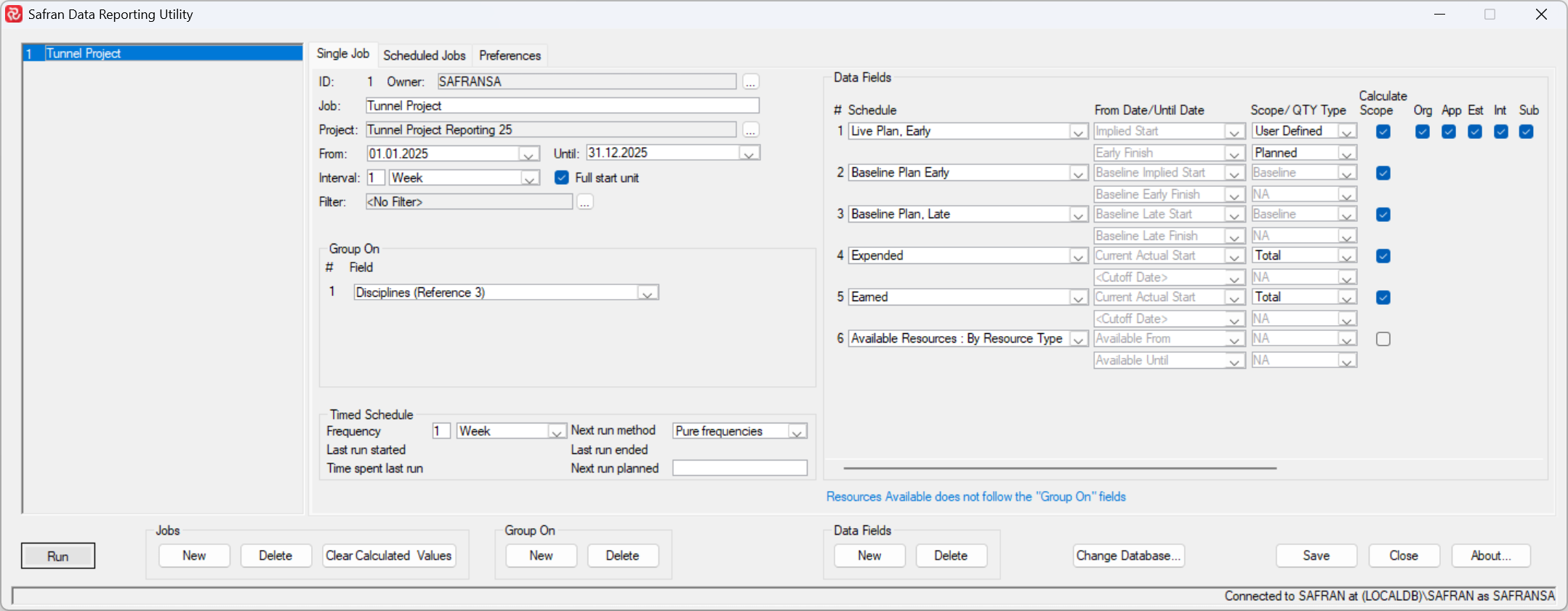
Job List
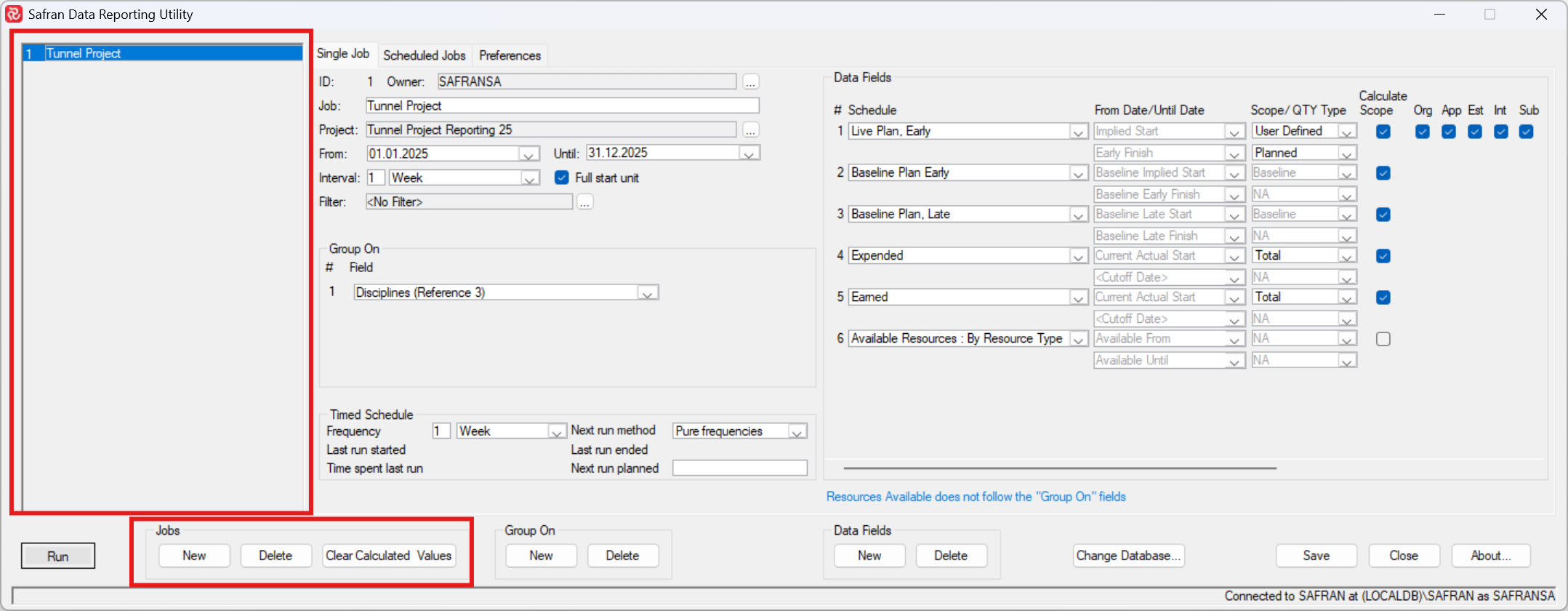
The job list is a comprehensive repository of all DRU jobs created in the database. This offers flexibility to create new jobs, delete unwanted jobs, and clear calculated values for a given job from the database. The list of jobs you can see is directly tied to what projects you can access in Safran Project. If you have at least Read access to the project schedule, you can run a DRU job created for the project. Only the owner of the job can edit the details of the job. If you are logged in as "SafranSA", you can see and manipulate all jobs.
Creating a New job starts by opening the familiar "Open" window in Safran Project. This window functions like in Safran Project, with access control in mind. Clicking cancel on the "Open" window will cancel the Job creation in the Data reporting utility (DRU).
Setup Tabs
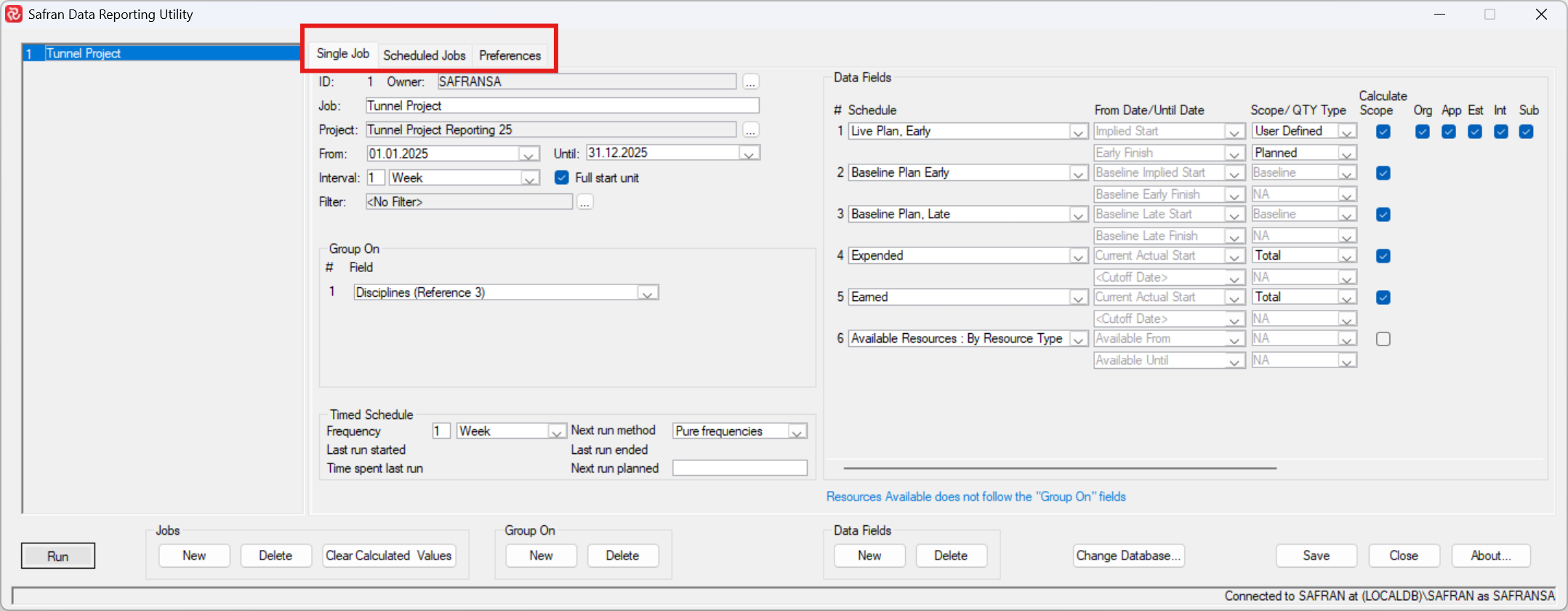
The Single Job tab is a pivotal component in the job setup process. It's where each job is configured and where scheduled jobs can be initiated or halted. The default run time method for new jobs is also established in the Preferences tab. Detailed descriptions of these tabs are provided in the configuration chapters.
Job Data

You can view or modify some of the job's specifics in this section. The specifics are as follows:
ID: Shows the ID of the selected job. This will be used as "job_id" in the database and "id" using Safran Reporting API.
Owner: Shows the owner of the selected job. The three dot button next to the owner's name can be used by the Owner or by SafranSA to change who owns the job. The list of users to choose from will be directly tied to who has access to the Project.
Job: Name of the job selected.
Project: Name of the project selected. Using the three dots next to the Project name enables the job Owner or SafranSA to change the project for the job.
From: Dictates the start of the first period that should be used in the aggregated results. This field allows the following:
Written dates "31.12.2025"
System globals: ex. <BaselineDate>, <DateTime>, <CutOffDate>, <Timenow> etc.
Project-defined Global dates: Any global defined in the Global Set in Safran Project for the project selected.
In addition, the globals and system globals allow simple math.
Example
<DateTime>-5d Result: Start date would be 5 days before <DateTime>
<DateTime>+6w Result: Start date would be 6w (6w times 7 days = 42days) after <DateTime>
Until: The same rules apply to this field, as "From" but it dictates how far out in time the aggregation should go.
Interval:
Interval in the Data Reporting Utility offers a variety of flexibility, and the output varies slightly between different project setups, depending on whether the "Full start unit" is ticked. The intervals supported are Day, Week, Bi-Week, Calendar Month, Project Month, Quarter and Year. You can also specify a number for the selected interval. For instance, 2 – Day will create two-day intervals.
Note: Using day intervals will produce a lot of data, especially for a big project with a lot of historical data. Choosing a narrow "from" to "until" date will drastically impact performance, as the number of rows generated will be directly proportional to the number of days.
Year, Quarter, and Calendar Month all follow the same pattern. The first period will be from the "From" date until the first year, quarter, and calendar month. They will then generate all the complete periods between the "From" and "Until" dates. The final period will be the time until the "Until" date.
Example,
| Description | From | Until | Full Start Unit |
|---|---|---|---|
| Interval: 1 Calendar Month | 16.01.2025 | 16.03.2025 | cell |
| 1st period | 16.01.2025 | 31.01.2025 | no |
| 2nd period | 01.02.2025 | 28.02.2025 | no |
| 3rd period | 01.03.2025 | 16.03.2025 | no |
| 1st period | 01.01.2025 | 31.01.2025 | yes |
| 2nd period | 01.02.2025 | 28.02.2025 | yes |
| 3rd period | 01.03.2025 | 31.03.2025 | yes |
Notice that this option attempts to give you full intervals. This is quite handy when you use globals as from-until fields.
Project Month and Biweek refer to the manual input flags in Cutoff Dates in Project Properties in Safran Project.
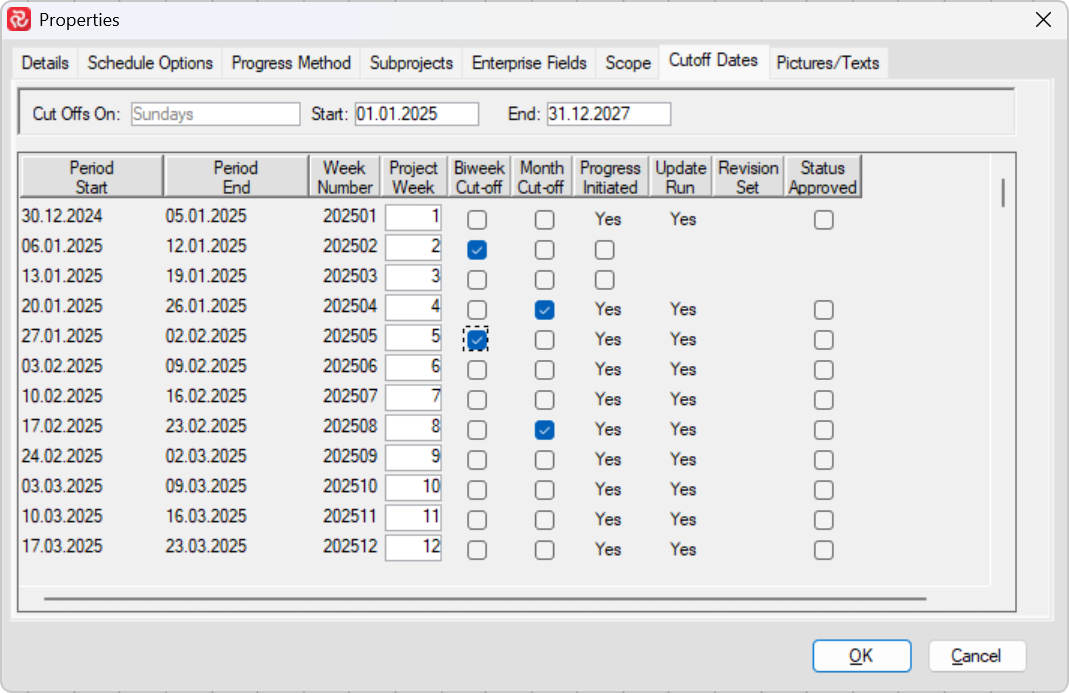
1 Week: This has two ways of operating, depending on your setup in Cutoff Dates.
If "Single Day Shifts" is defined as Cut Offs, 1 week will be defined as "From" date + 7 days.
If you have, for instance, "Sundays" or "Mondays" defined as cut-offs, 1 week will be defined as Monday- Sunday, or Tuesday – Monday intervals, respectively.
1 day: Lowest interval available, will create an interval for each day between "From" and "Until".
Filter:
Using the 3dot box, you can create a new or select a defined filter that the aggregation will use. This will limit the activities that are considered for the output. For instance, you could set up a filter like Cancelled is null to remove cancelled activities.
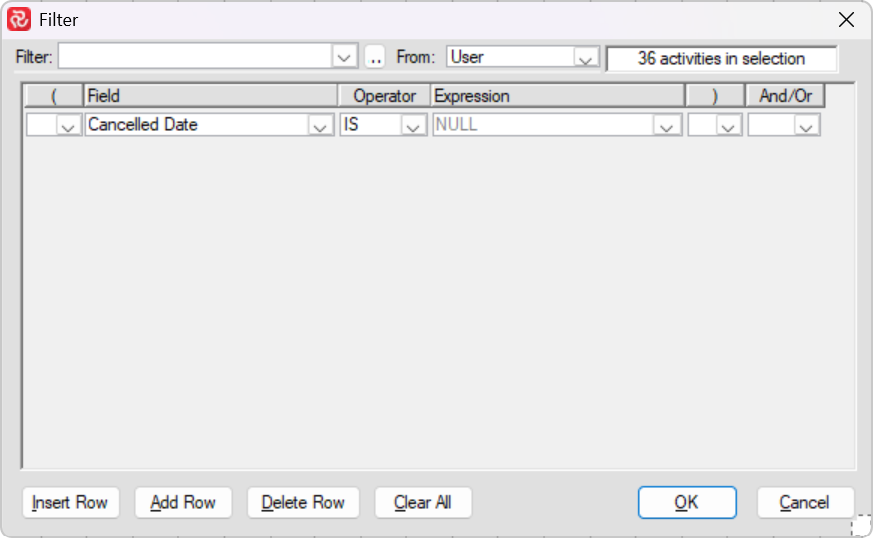
Group On

This configuration lets you choose how the output should be grouped. This includes "New" and "Delete" buttons to create or delete additional grouping. If more than one grouping is selected, the combination will be the result, similar to "Group Properties" in the Barchart Editor of Safran Project. It is recommended to start with Activity ID,
Data Fields
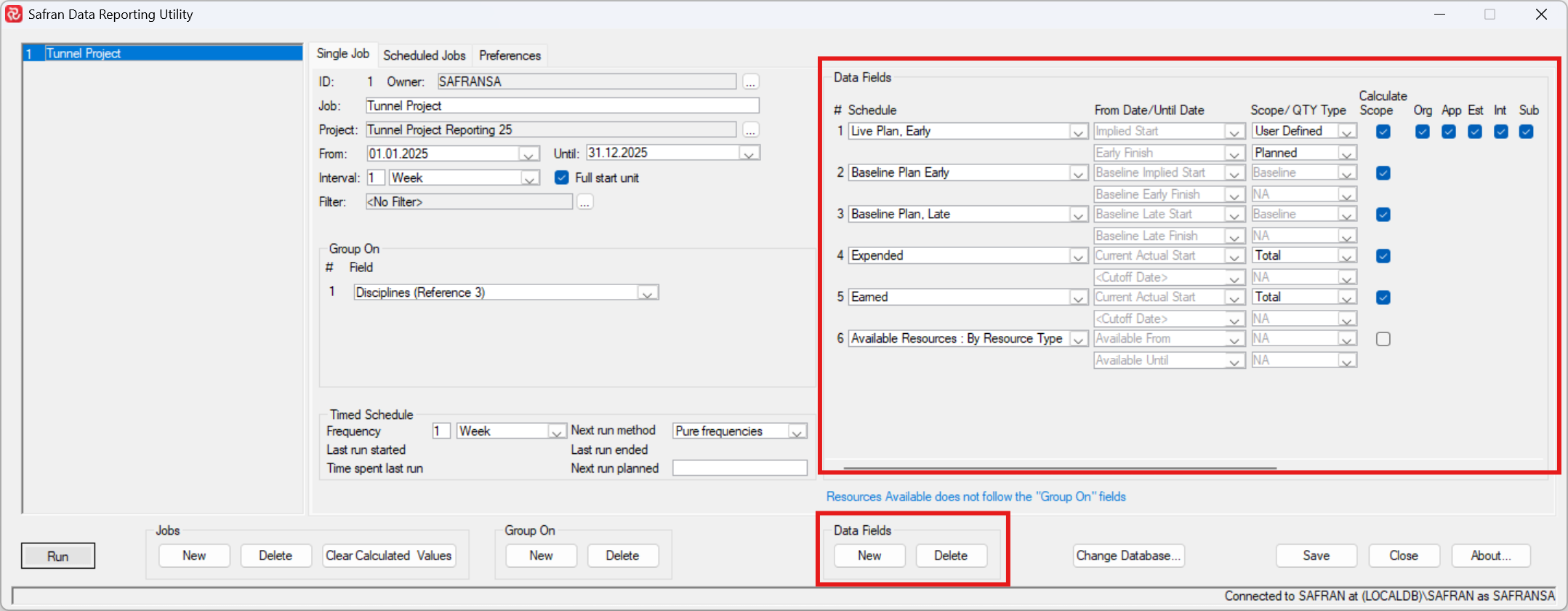
Includes New and Delete buttons to create new or remove existing data fields. There are multiple input parameters to consider here, offering complete functionality flexibility.
Schedule
A dropdown containing most data, including Live Plan, Current Plan, Baseline Plan, Earned, Expended, Forecast, Computed decimal field, and any regular decimal field can be aggregated. The list will be populated based on the project selected, so if there is no calculated decimal field, the list will reflect this.
From Date / Until Date
Most of the regular schedules will have these options greyed out. However, some allow you to manipulate what date field should be used as start date, and what field should be used as until date. It is recommended that the default is used in most cases.
Scope / QTY type
These are two settings. Scope allows you to choose between "Baseline", "Current", "User Defined", and "Total". Using "User Defined" also enables five additional tickboxes, allowing you to control the types of VO resources in the calculation. QTY type enables you to differentiate between "Planned" and "Contract" like Barchart Editor Histogram.
Timed Schedule

This allows you to set up a job schedule.
Frequency
Allows setting the report generation frequency.
Next run method
Pure frequencies – will run purely on the frequency selected (Default)
Last run started – will set up the next run based on when it began last.
Last run ended – will set up the next run based on when it finished last.
Additional buttons
Run
Start the selected job.
Save
Saves configurations made to the selected job.
Close
Closes the Safran Data Reporting Utility.
Change database
Allows changing database or logged-in user.
About
Shows key information about the DRU version and system details.
Scheduled Jobs
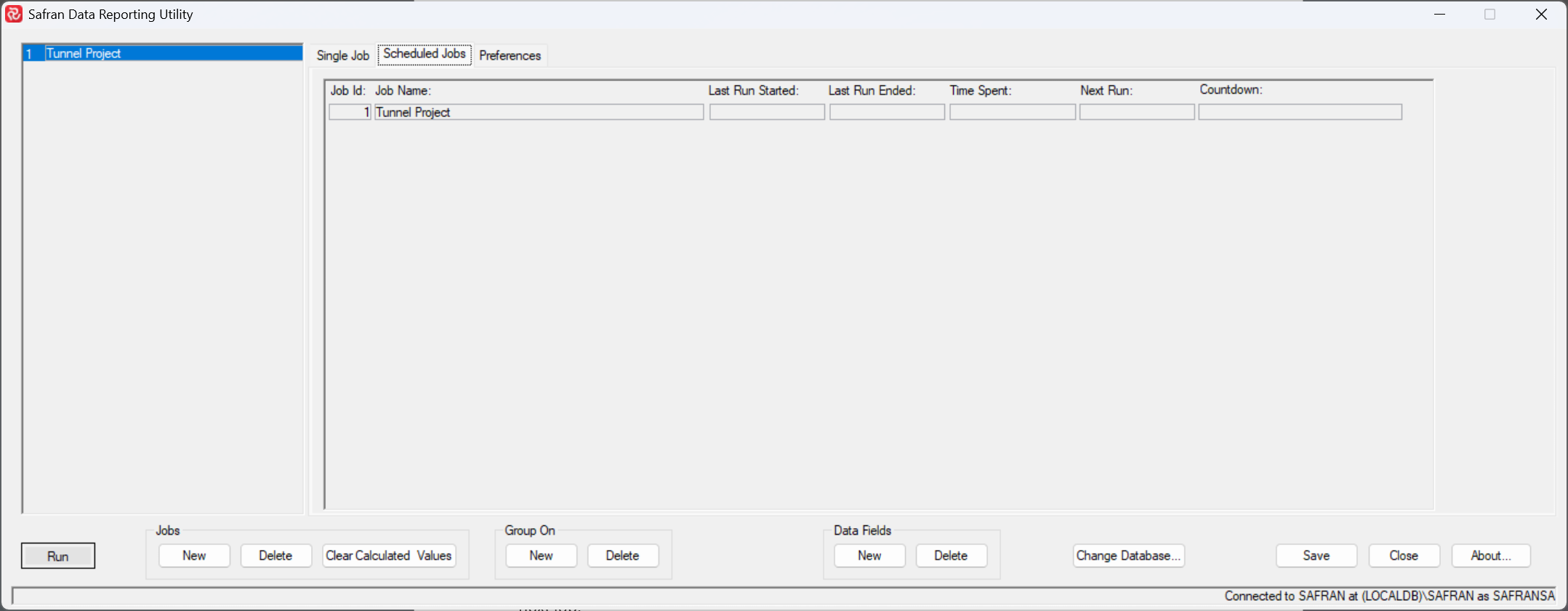
In this tab, you will see an overview of all jobs. If they have a next run date, they are scheduled to run on that date/time, and a countdown is attached.
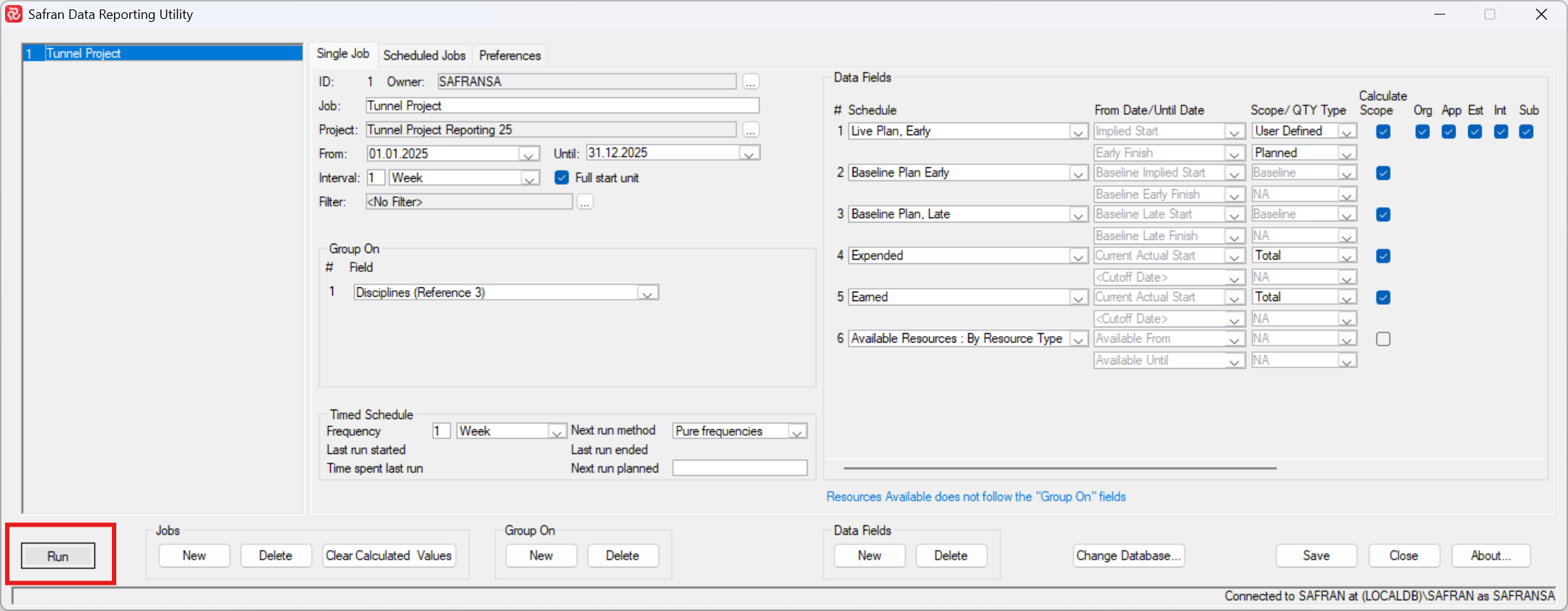
Clicking the "Run" button while this tab is open will start the automated run. The DRU will cycle through all jobs, running a minor refresh between each job. This is to ensure that any updates made by anyone else (new run interval, job deleted, etc) will be captured by the automatic job.
Once the automated job has been completed for a given project, it will update the last run started, last run ended, time spent and next run date. Then, the automation will continue with the next job.
Safran Project Data Reporting API
The Data Reporting Utility enables users to define aggregation jobs and generate aggregated results. The job definitions and results are stored in your database and can be accessed through this API.
For details see the Safran Reporting API.